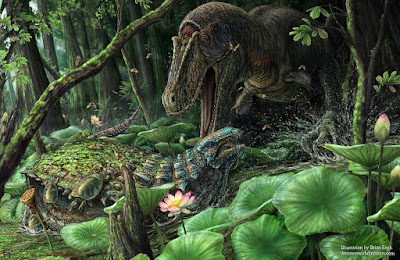| Image may be NSFW. Clik here to view.  |
Rhinogobius maculagenys |
Abstract
A new freshwater goby, Rhinogobius maculagenys sp. nov., was collected from Hunan Province in Southern China. This species can be distinguished from all congeners by a combination of the following features: first dorsal fin with 6 spines; second dorsal fin with a single spine and 7–9 segmented rays; anal fin with a single spine and 6–8 segmented rays; pectoral fin with 16 segmented rays; 32–34 longitudinal scales; 9–13 transverse scales; 11+16=27 vertebrae; pore ω1 missing; head and body yellowish brown; cheek and opercle yellowish brown with over 30 small orange spots, branchiostegal membrane yellow with over 10 small orange spots in males and white and spotless in females; first dorsal fin trapezoidal in males and nearly semicircular in females, with large bright blue blotch in front of second spine; spines 4 and 5 longest, rear tip extending to base of second branched ray of second dorsal fin in males when adpressed, but just reaching or not reaching anterior margin of second dorsal fin in females; caudal fin with 5–6 vertical rows of brown spots; flank with several longitudinal rows of blackish-brown spots; and belly pale white.
Key words: Xiangjiang, fish taxonomy, valid species, color pattern
| Image may be NSFW. Clik here to view.  |
| FIGURE 4 Rhinogobius maculagenys sp. nov. Lateral (a) and ventral (c) views of paratype, male, HUNNULS2017-12-0613, 39.85 mm SL; lateral (b) and ventral (d) views of paratype, female, HUNNULS2017-12-0612, 44.50 mm SL. |
Rhinogobius maculagenys sp. nov.
Diagnosis. Rhinogobius maculagenys is distinguished from all congeners by a combination of the following features: second dorsal-fin rays I/7–9; anal-fin rays I/6–8; pectoral-fin rays 16; longitudinal scale series 32–34; transverse scale series 9–13; predorsal scale series 0; vertebral count 11+16=27; pore ω1 missing; head and body yellowish brown; cheek and opercle yellowish brown with over 30 small orange spots, branchiostegal membrane yellow with over 10 small orange spots in males and white and spotless in females; first dorsal fin trapezoidal in males and nearly semicircular in females, with large bright blue blotch in front of second spine; spines 4 and 5 longest, rear tip extending to base of second branched ray of second dorsal fin in males when adpressed, but just reaching or not reaching anterior margin of second dorsal fin in females; caudal fin with 5–6 vertical rows of brown spots; flank with several longitudinal rows of blackish-brown spots; belly pale white.
....
Distribution and habitat. The species is only known from Zhong Water, in the upper reaches of the Xiangjiang River on Lanshan County, Hunan Province. This species may be endemic within this basin.
Etymology. The specific name, maculagenys, from the Latin macula meaning spot and genys meaning cheek, in reference to the diagnostic feature of round orange spots on cheek. To be treated as a noun in apposition.
Qianqian Wu, Xuejian Deng, Yanjie Wang and Yong Liu. 2018. Rhinogobius maculagenys, A New Species of Freshwater Goby (Teleostei: Gobiidae) from Hunan, China. Zootaxa. 4476(1); 118–129. DOI: 10.11646/zootaxa.4476.1.11





















































































